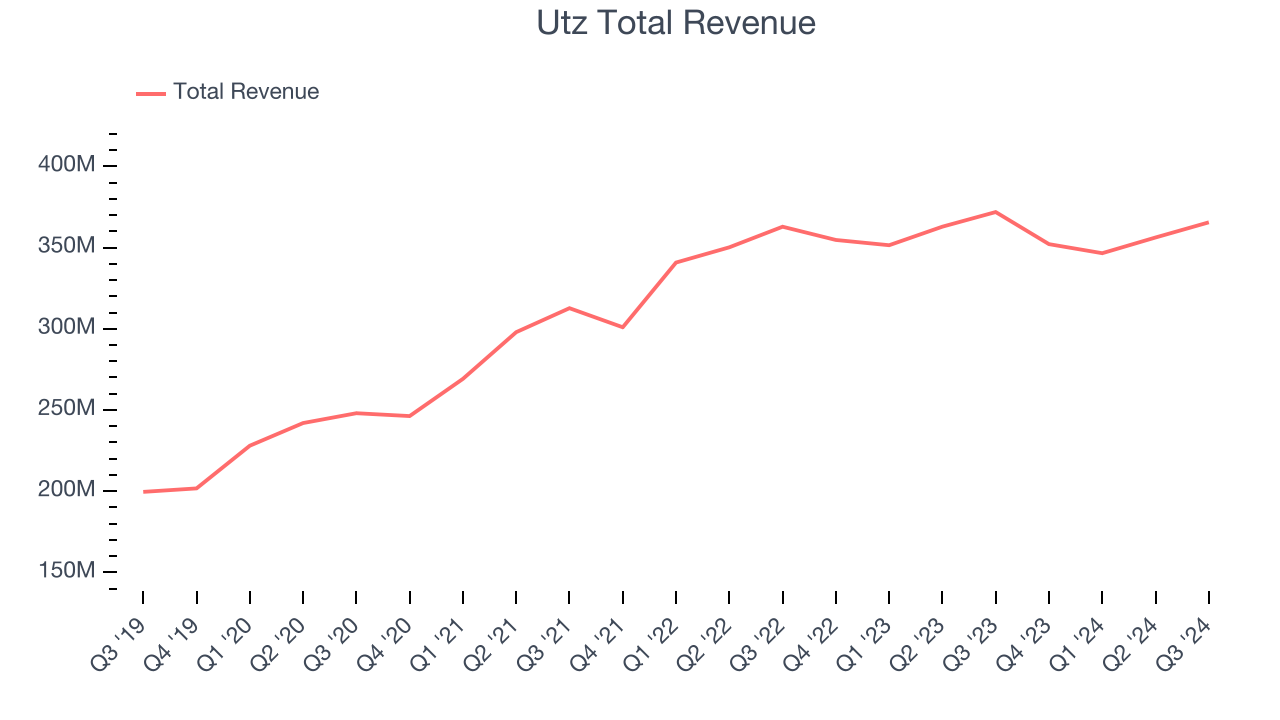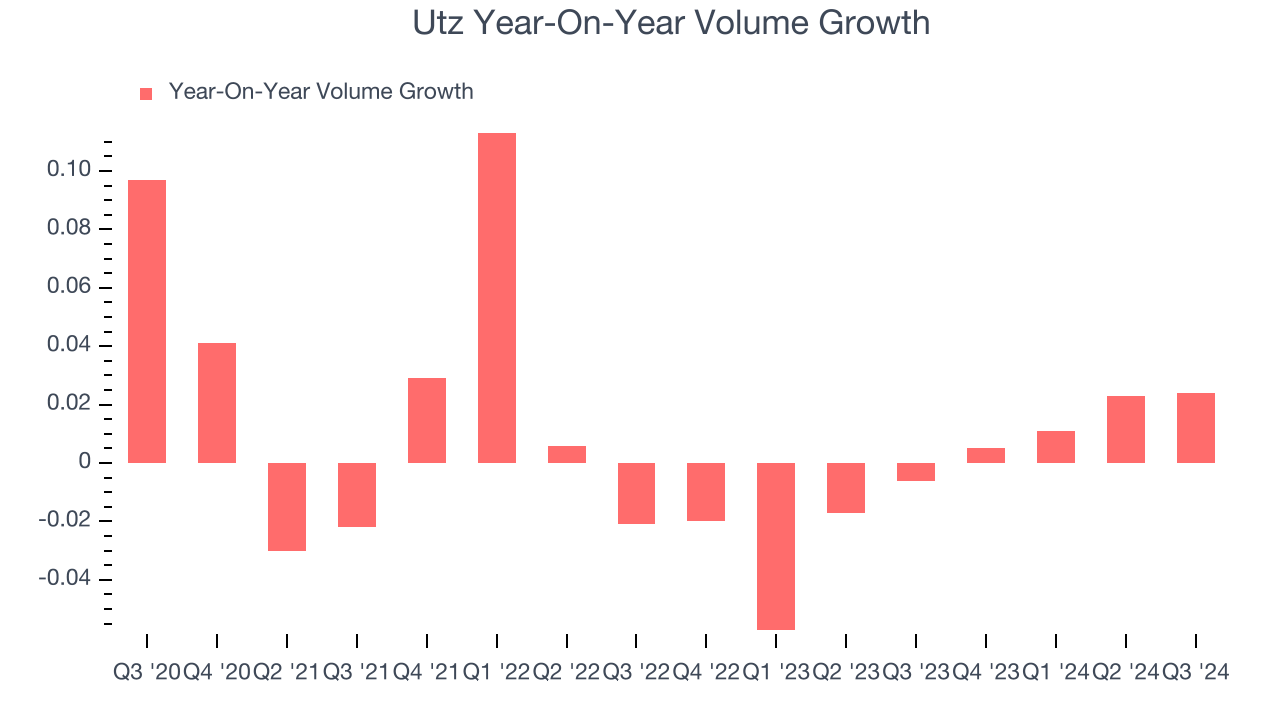
Snack food company Utz Brands (NYSE: UTZ) met Wall Street’s revenue expectations in Q3 CY2024, but sales fell 1.7% year on year to $365.5 million. Its non-GAAP profit of $0.21 per share was 4.5% above analysts’ consensus estimates.
Is now the time to buy Utz? Find out by accessing our full research report, it’s free.
Utz (UTZ) Q3 CY2024 Highlights:
- Revenue: $365.5 million vs analyst estimates of $364.3 million (in line)
- Adjusted EPS: $0.21 vs analyst estimates of $0.20 (beat by $0.01)
- EBITDA: $54 million vs analyst estimates of $53.65 million (small beat)
- Gross Margin (GAAP): 35.8%, up from 32.1% in the same quarter last year
- Operating Margin: 5.3%, up from 1.4% in the same quarter last year
- EBITDA Margin: 14.8%, down from 17% in the same quarter last year
- Free Cash Flow Margin: 7.9%, down from 10.2% in the same quarter last year
- Organic Revenue rose 1.9% year on year (3.1% in the same quarter last year)
- Sales Volumes rose 2.4% year on year (-0.6% in the same quarter last year)
- Market Capitalization: $1.34 billion
"In the third quarter our momentum continued with solid Organic Net Sales growth, our seventh consecutive quarter of Adjusted EBITDA Margin expansion, and Adjusted Earnings Per Share growth of nearly 24%,” said Howard Friedman, Chief Executive Officer of Utz.
Company Overview
Tracing its roots back to 1921 when Bill and Salie Utz began making potato chips in their kitchen, Utz Brands (NYSE: UTZ) offers salty snacks such as potato chips, tortilla chips, pretzels, cheese snacks, and ready-to-eat popcorn, among others.
Shelf-Stable Food
As America industrialized and moved away from an agricultural economy, people faced more demands on their time. Packaged foods emerged as a solution offering convenience to the evolving American family, whether it be canned goods or snacks. Today, Americans seek brands that are high in quality, reliable, and reasonably priced. Furthermore, there's a growing emphasis on health-conscious and sustainable food options. Packaged food stocks are considered resilient investments. People always need to eat, so these companies can enjoy consistent demand as long as they stay on top of changing consumer preferences. The industry spans from multinational corporations to smaller specialized firms and is subject to food safety and labeling regulations.
Sales Growth
A company’s long-term performance is an indicator of its overall business quality. While any business can experience short-term success, top-performing ones enjoy sustained growth for multiple years.
Utz is a small consumer staples company, which sometimes brings disadvantages compared to larger competitors benefitting from economies of scale.
As you can see below, Utz’s sales grew at a decent 8% compounded annual growth rate over the last three years despite selling a similar number of units each year. We’ll explore what this means in the "Volume Growth" section.

This quarter, Utz reported a rather uninspiring 1.7% year-on-year revenue decline to $365.5 million of revenue, in line with Wall Street’s estimates.
Looking ahead, sell-side analysts expect revenue to grow 3.2% over the next 12 months, a deceleration versus the last three years. This projection doesn't excite us and shows the market thinks its products will face some demand challenges.
Today’s young investors won’t have read the timeless lessons in Gorilla Game: Picking Winners In High Technology because it was written more than 20 years ago when Microsoft and Apple were first establishing their supremacy. But if we apply the same principles, then enterprise software stocks leveraging their own generative AI capabilities may well be the Gorillas of the future. So, in that spirit, we are excited to present our Special Free Report on a profitable, fast-growing enterprise software stock that is already riding the automation wave and looking to catch the generative AI next.
Volume Growth
Revenue growth can be broken down into changes in price and volume (the number of units sold). While both are important, volume is the lifeblood of a successful staples business as there’s a ceiling to what consumers will pay for everyday goods; they can always trade down to non-branded products if the branded versions are too expensive.
To analyze whether Utz generated its growth from changes in price or volume, we can compare its volume growth to its organic revenue growth, which excludes non-fundamental impacts on company financials like mergers and currency fluctuations.
Over the last two years, Utz’s quarterly sales volumes have, on average, stayed about the same. This stability is normal as the quantity demanded for consumer staples products typically doesn’t see much volatility. The company’s flat volumes also indicate its average organic revenue growth of 4% was generated from price increases.

In Utz’s Q3 2024, sales volumes jumped 2.4% year on year. This result was a well-appreciated turnaround from the 0.6% year-on-year decline it posted 12 months ago, showing the company is heading in the right direction.
Key Takeaways from Utz’s Q3 Results
We were impressed by how significantly Utz blew past analysts’ organic revenue growth expectations this quarter. We were also happy its EPS narrowly outperformed Wall Street’s estimates. On the other hand, its gross margin missed analysts’ expectations. Zooming out, we think this was a decent quarter featuring some areas of strength. The stock remained flat at $16.30 immediately following the results.
Should you buy the stock or not? We think that the latest quarter is only one piece of the longer-term business quality puzzle. Quality, when combined with valuation, can help determine if the stock is a buy. We cover that in our actionable full research report which you can read here, it’s free.





